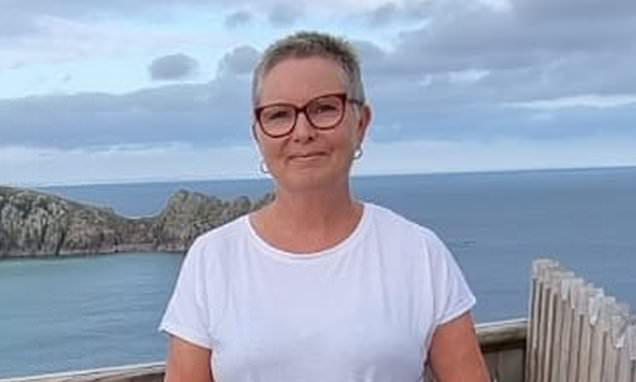Breakthrough to help spot ovarian cancer before it's too late
Doctors make breakthrough to help spot ovarian cancer before it’s too late… but campaigners fear women may not benefit for years without funding boost
- Doctors found women at risk of ovarian cancer have high level of specific protein
- University of Oxford team developing screening test for women over age of 45
- For test to be rolled out within next decade, charities say more funding is needed
- Believed ovarian cancer receives £9m of research funding a year compared to £55m for breast cancer
British doctors have made a breakthrough that could finally pave the way for a national ovarian cancer-screening programme.
Researchers have discovered that women at risk of developing the deadly disease have high levels of a specific protein in their bodies.
Based on this, the University of Oxford team are now developing a test that could be offered every five years to women over the age of 45.
Women at higher risk of the disease, such as those with a family history of ovarian cancer or those with high-risk genetic mutations, could be tested every two years.
‘This could be the magic bullet for early ovarian-cancer detection,’ says Oxford-based cancer specialist Dr Mara Artibani, who has been working on the research.

British doctors have made a breakthrough that could finally pave the way for a national ovarian cancer-screening programme. One patient who would have benefited from screening is Marion Bradford, 57, from Surrey, who was diagnosed with ovarian cancer in November 2017
The protein, known as SOX2, is produced in the fallopian tubes in high levels if a woman is in the early stages of ovarian cancer.
Researchers are trying to work out whether a blood test, or a swab similar to a smear test, will be the best way to detect it.
Nearly 7,000 women are diagnosed with ovarian cancer every year in the UK. Fewer than half survive more than five years. More than 4,000 die of the disease annually.
Prospects are bleak as initial symptoms – such as bloating, appetite loss and needing to go to the toilet more – are often mistaken for other health problems so cases are often not picked up until the cancer has spread throughout the body.
The risk of developing ovarian cancer increases steeply from about 45, and is more common in women with a family history of the disease. Despite this, the creation of a screening test to detect the cancer at an early stage has eluded doctors.
Hopes were dashed last year when a major ovarian cancer-screening trial failed to deliver results. It involved offering women an annual blood test for a different ovarian cancer-related protein, called CA125, and an ultrasound scan.

Women at higher risk of the disease, such as those with a family history of ovarian cancer or those with high-risk genetic mutations, could be tested every two years (stock photo)
It revealed 40 per cent more cancers than current methods – which wait to test women when they see a doctor with concerns about symptoms – but it did not lead to a reduction in deaths because high levels of CA125 are produced only once the cancer is advanced.
By comparison, SOX2, the protein discovered by the Oxford team, is an accurate indicator of the disease, even in its earliest stages.
As SOX2 is found only on fallopian tubes, the test being developed will hopefully identify a yet-to-be-discovered chemical ‘by-product’ linked to the protein that can be seen in the blood or on the uterus lining.
Once it is identified, scientists can start testing a screening tool for it.
‘If this by-product is found in the blood, we will design a blood test; and if it’s on the uterus lining, we can create a smear test,’ says Dr Artibani.
She added that, given the accuracy of SOX2 at predicting cancer, the test would only have to be given to women over the age of 45 every five years, or every two years for those with a heightened risk.
But for this test to be rolled out within the next decade, charities say more funding is needed.
IT’S A FACT
One in five ovarian cancers has a genetic cause – and in most of these cases, a member of the immediate family will have had the disease.
‘Ovarian cancer research requires much more investment if we want to have any hope of developing an effective screening tool to catch the disease early,’ says Cary Wakefield, of Ovarian Cancer Action.
The group says ovarian cancer receives £9 million of research funding a year. By comparison, breast cancer receives £55 million.
One patient who would have benefited from screening is Marion Bradford, 57, from Surrey, who was diagnosed with ovarian cancer in November 2017.
The former teaching assistant began feeling bloated and fatigued in 2016 and had severe stomach pains a few months before her diagnosis.
Her concerns were initially dismissed by doctors because she didn’t fit the typical description of an ovarian cancer patient.
She says: ‘I was told that I was too young, and I didn’t have anyone in my family who’d had it, so the doctors said it was really unlikely to be cancer.’
But when the pains intensified, Marion pushed for another appointment and was eventually able to get an ultrasound scan, and then a few weeks later a biopsy.
‘When I showed up to get my results, a Macmillan nurse was waiting with the doctor. I was told the cancer had spread, and that I’d need to start chemo straight away.’
The mother-of-three underwent two rounds of chemo, after the disease returned in 2020, and she still takes medication now.
She believes a screening test would have spared her years of treatment. ‘I never realised something was wrong until things were really serious,’ she says.
‘Before I had a hysterectomy, I went for my cervical cancer screening every time, and I have annual mammograms to look for breast cancer.
‘Why isn’t there a way to do the same for ovarian cancer?’
Hospital’s app gives throat op patients a new voice
Hospital patients hooked up to breathing tubes and unable to talk may soon be able to communicate using a phone app that reads lips.
The technology is being trialled at Lancashire Teaching Hospitals NHS Trust on patients who have had a tracheostomy – where a tube is inserted into the windpipe and a machine helps them to breathe.
A tracheostomy is performed on about one in six people admitted to NHS intensive care wards.
Many of these patients are suffering with respiratory diseases, such as Covid, which make breathing difficult, as well as other serious conditions, including certain cancers or traumatic head injuries.
Patients can spend anything from a few days to months connected to the tube. But while it is often a lifesaving intervention, patients cannot use their vocal cords so struggle to communicate.
According to Dr Shondipon Laha, an intensive care consultant who came up with the idea for the app and is leading the trial, a tracheostomy can be isolating for patients and affect their care.
He said: ‘Patients may need the toilet, be in pain or have a particular concern they want to raise, but they aren’t able to communicate this to doctors or relatives who come to visit, which can be hugely frustrating.’
The cutting-edge technology hopes to remedy this.
To use the app, patients aim the camera on their smartphone at their face. Sophisticated software reads their lips as they mouth words, which are then displayed on the phone’s screen where it can be read by doctors and visitors.
The app, designed by Northern Ireland-based software company Liopa, currently recognises 40 phrases, such as ‘I need the toilet’, ‘I want to speak to my family’ or ‘I feel sad’.
It hopes to expand the number of phrases the app understands and also make it able to speak the patient’s words.
Dr Laha first had the idea for the app during the 2018 football World Cup.
He said: ‘I was on the ward and there was a patient with a tracheostomy who shoved me really hard in the back. He was trying to watch a penalty shootout and I was in the way.
‘I realised then that it would be useful to have something that could help these patients talk.’
Trials carried out on 12 patients at the hospital in 2019 showed it was effective and popular.
Dr Laha added: ‘If this goes well we could extend it to other NHS trusts across the country.’
Source: Read Full Article
